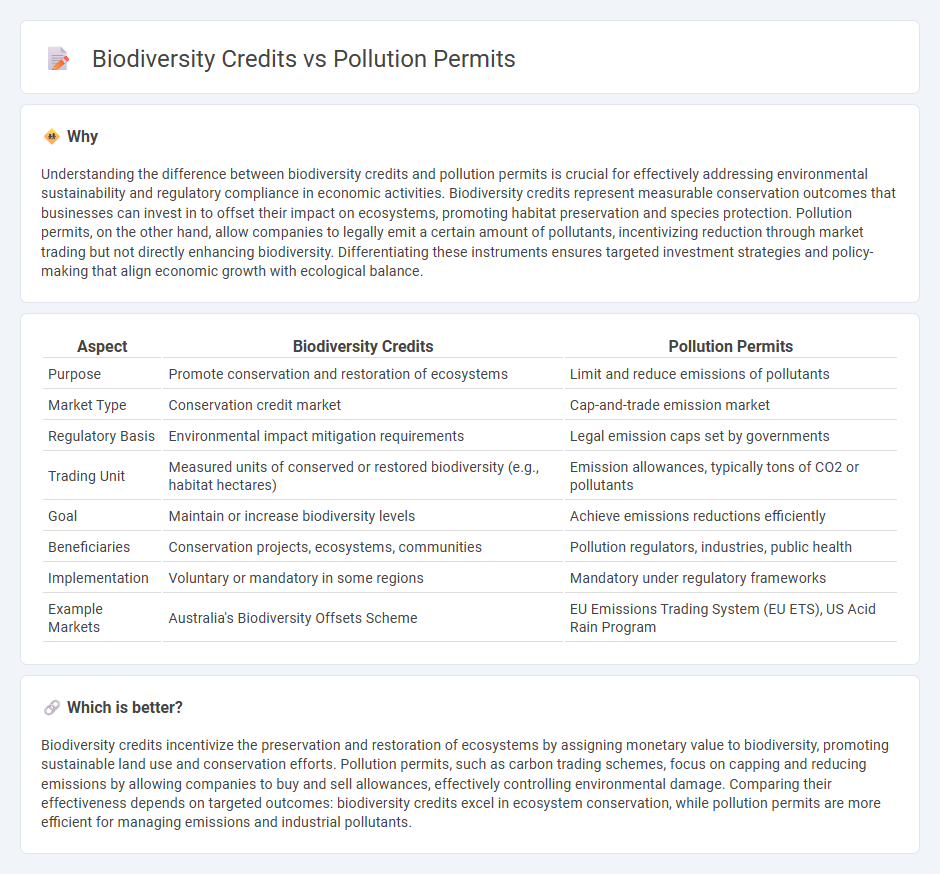
Biodiversity credits represent a market-based approach to conserving natural habitats by assigning economic value to ecosystem preservation, while pollution permits regulate emissions by setting limits and allowing trading among polluters. These mechanisms aim to balance economic growth with environmental sustainability through financial incentives and regulatory frameworks. Explore the differences and impacts of these environmental finance tools to better understand their roles in promoting ecological resilience.
Why it is important
Understanding the difference between biodiversity credits and pollution permits is crucial for effectively addressing environmental sustainability and regulatory compliance in economic activities. Biodiversity credits represent measurable conservation outcomes that businesses can invest in to offset their impact on ecosystems, promoting habitat preservation and species protection. Pollution permits, on the other hand, allow companies to legally emit a certain amount of pollutants, incentivizing reduction through market trading but not directly enhancing biodiversity. Differentiating these instruments ensures targeted investment strategies and policy-making that align economic growth with ecological balance.
Comparison Table
| Aspect | Biodiversity Credits | Pollution Permits |
|---|---|---|
| Purpose | Promote conservation and restoration of ecosystems | Limit and reduce emissions of pollutants |
| Market Type | Conservation credit market | Cap-and-trade emission market |
| Regulatory Basis | Environmental impact mitigation requirements | Legal emission caps set by governments |
| Trading Unit | Measured units of conserved or restored biodiversity (e.g., habitat hectares) | Emission allowances, typically tons of CO2 or pollutants |
| Goal | Maintain or increase biodiversity levels | Achieve emissions reductions efficiently |
| Beneficiaries | Conservation projects, ecosystems, communities | Pollution regulators, industries, public health |
| Implementation | Voluntary or mandatory in some regions | Mandatory under regulatory frameworks |
| Example Markets | Australia's Biodiversity Offsets Scheme | EU Emissions Trading System (EU ETS), US Acid Rain Program |
Which is better?
Biodiversity credits incentivize the preservation and restoration of ecosystems by assigning monetary value to biodiversity, promoting sustainable land use and conservation efforts. Pollution permits, such as carbon trading schemes, focus on capping and reducing emissions by allowing companies to buy and sell allowances, effectively controlling environmental damage. Comparing their effectiveness depends on targeted outcomes: biodiversity credits excel in ecosystem conservation, while pollution permits are more efficient for managing emissions and industrial pollutants.
Connection
Biodiversity credits and pollution permits function as market-based instruments designed to internalize environmental externalities, enabling companies to offset their ecological impacts while adhering to regulatory limits. Both systems incentivize sustainable practices by putting a monetary value on natural capital and pollution reduction, fostering a balance between economic growth and environmental protection. These mechanisms contribute to the development of green finance markets, supporting the transition to a low-carbon, biodiversity-friendly economy.
Key Terms
Cap-and-trade
Cap-and-trade systems primarily target pollution permits, enabling companies to buy and sell allowances that limit greenhouse gas emissions. Biodiversity credits, however, represent a newer market mechanism focused on conserving habitats and species by assigning tradable credits for ecological preservation efforts. Explore the evolving role of cap-and-trade in balancing economic activity with environmental protection through both pollution permits and biodiversity credits.
Ecosystem services
Pollution permits regulate emissions by capping pollutants and allowing market trading to incentivize reduction efforts, whereas biodiversity credits focus on preserving or restoring ecosystem services like habitat provision, water filtration, and carbon sequestration through measurable conservation actions. Ecosystem services underpin both systems but biodiversity credits emphasize direct ecological benefits and habitat integrity, supporting species diversity and ecosystem resilience. Explore how integrating these market-based tools can enhance environmental outcomes and sustainable development goals.
Offset markets
Pollution permits regulate emissions by setting a cap and allowing trading to incentivize reduction, while biodiversity credits fund conservation projects that enhance ecosystems and habitat preservation. Offset markets for pollution permits primarily target air and water quality improvements, whereas biodiversity credits support the protection of species diversity and natural habitats. Explore how these markets balance economic growth with environmental sustainability to learn more.
Source and External Links
Pollution permit trading | EBSCO Research Starters - Pollution permits, or cap-and-trade systems, allow companies to buy and sell rights to emit pollutants within a total emission limit set by regulators, encouraging cost-effective pollution reduction and creating a market for emissions rights.
Pollution Permits - Economics Help - Pollution permits grant firms legal rights to emit a set amount of pollution, enabling them to trade permits to meet emission targets, providing market incentives to reduce pollution and external costs like global warming.
The Pros and Cons of Pollution Permit Trading - Seaside Sustainability - Pollution permit trading (emissions trading or cap-and-trade) is a market-based approach that limits pollution by creating tradable allowances, offering cost-effectiveness, flexibility, and international cooperation opportunities while incentivizing innovation.
 dowidth.com
dowidth.com